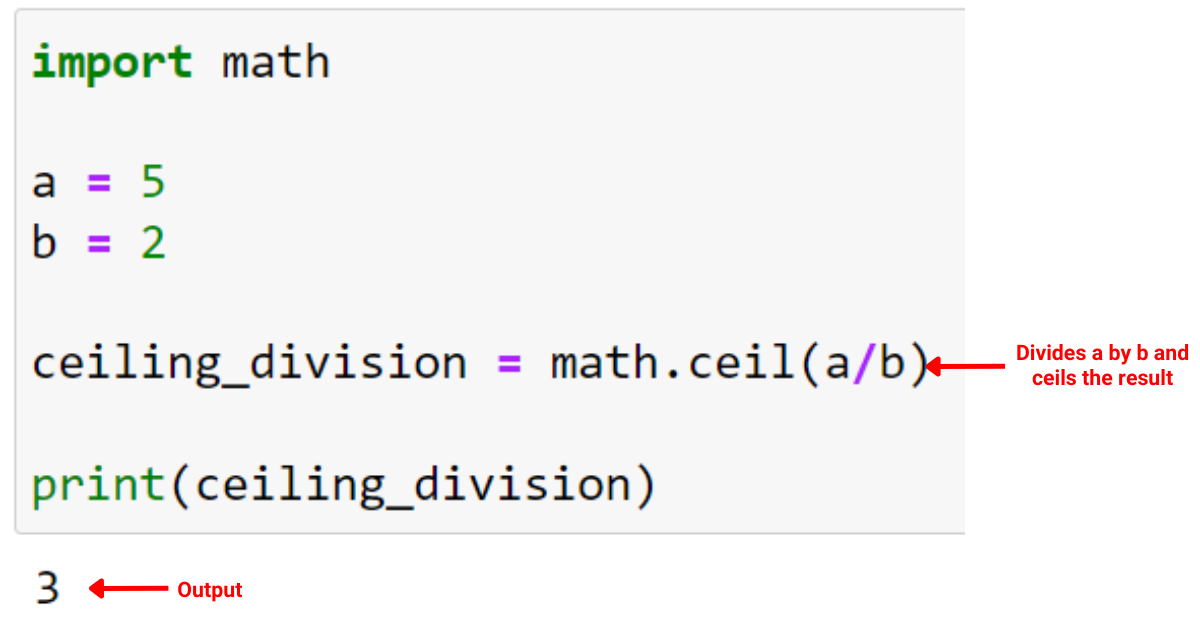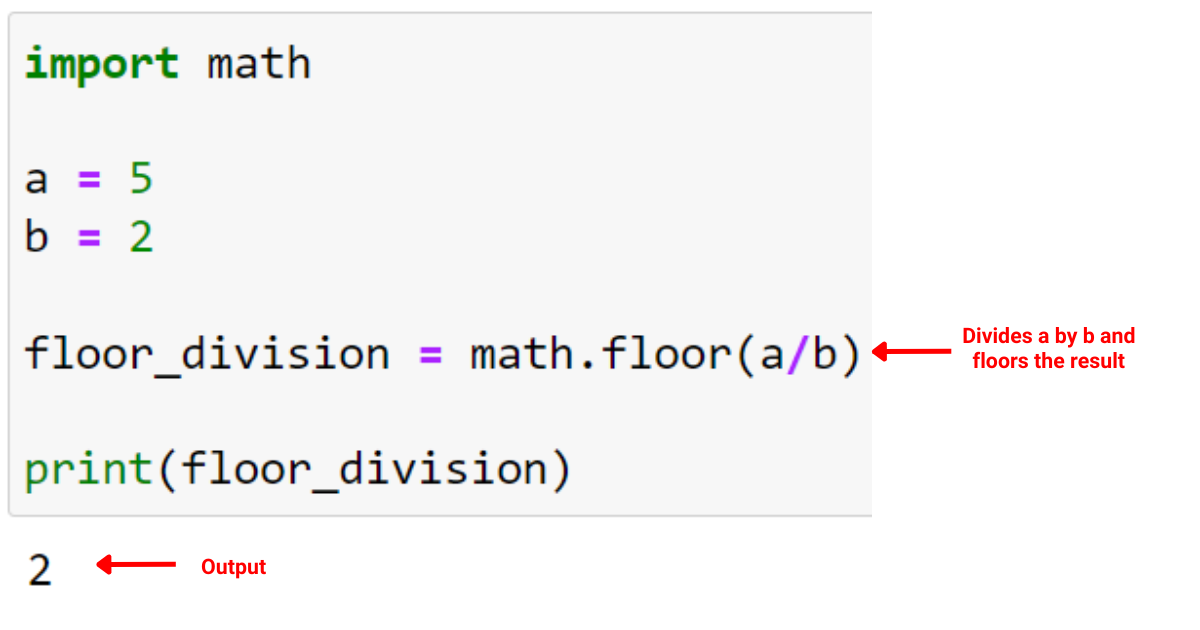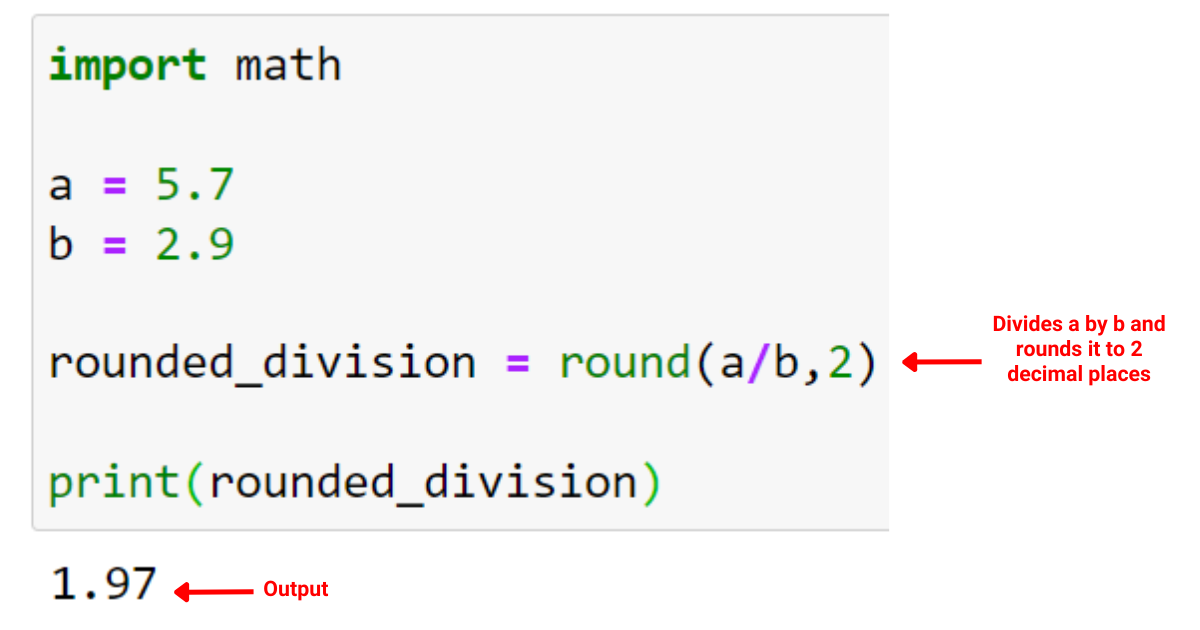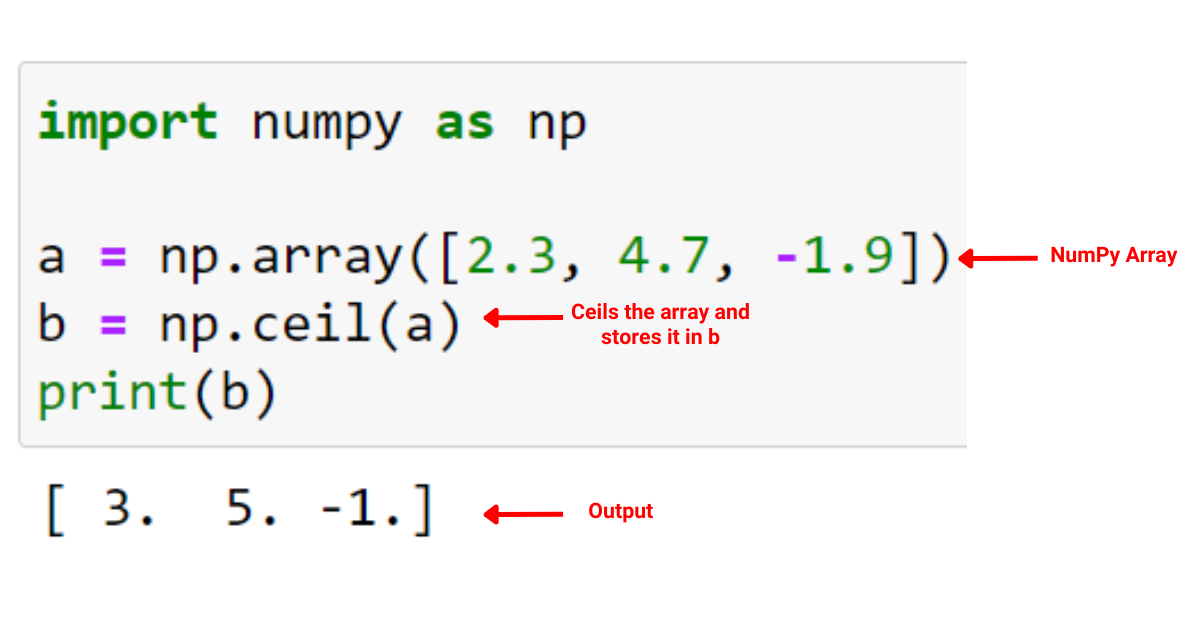In programming, it’s common for developers to perform various arithmetic operations. One of these operations includes ceiling division, which divides a number by zero, and the result is rounded to the nearest whole number. By using ceiling division, you can obtain the smallest integer greater than or equal to the result of the division.
To perform ceiling division in Python, use the math library’s ceil() function. The function rounds the number up to the smallest integer greater than or equal to it. You can also perform ceiling division by using the floor division operator and double negation to achieve your desired result.

Understanding Python’s ceiling division is important if you want to ensure that your code remains error-free.
In this article, we’ll explore how you can perform ceiling division in Python. We’ll also look at specific examples of ceiling division to help you better understand the concept.
Let’s get into it!
How to Perform Ceiling Division in Python
Before we look at the code for ceiling division in Python, it’s important to understand the functions we use to perform these operations.
The two most important functions from the math module in Python are:
- Ceil Function
- Floor Function
1. How to Use the Ceil Function in Python
Python’s ceil() function allows you to round a number up.
For instance, ceil(2.3) will result in 3.
In Python, you can achieve this by using the math.ceil() function. The math.ceil() function is a part of the math package in Python. It’s helpful for performing ceiling operations, as it returns the smallest integer greater than or equal to the given number.
To use the math.ceil() function, you need to import the math package at the beginning of your code:
import math
result = math.ceil(2.3)
print(result)
# Output: 3To perform ceiling division with the math.ceil() function, simply divide two numbers and pass the result to the math.ceil() function:
import math
a = 5
b = 2
ceiling_division = math.ceil(a/b)
print(ceiling_division) In this Python code, we’re performing integer division of a by b and then rounding it up with the math.ceil function. The output is a ceiling value as shown below:

2. How to Use the Floor Function
The floor function allows you to round a number down to the nearest integer.
For instance, math.floor(2.9) will give you 2.
You can use the math.floor() function in Python to round a number down.
To use the math.floor() function, you need to import the math package at the beginning of your code:
import math
result = math.floor(2.3)
print(result)
# Output: 2To perform the Python floor division with the math.floor() function, simply divide two numbers and pass the result to the math.floor() function:
import math
a = 5
b = 2
floor_division = math.floor(a/b)
print(ceiling_division) In this Python code, we are dividing a by b and then rounding it up with the math.floor function. The math.floor() function returns a number rounded down. The output is given below:

How to Use the Floor Division Operator in Python
You can also use the floor division operator (//) to perform division in Python. It behaves similarly to the normal division operator /. However, instead of returning a floating-point number, it returns the largest integer value smaller than or equal to the division result.
For example, 7 // 2 will return 3 because the largest integer that is smaller than or equal to 3.5 is 3.
The floor division operator rounds the result down. However, you can mimic the behavior of the ceiling division using the floor division operator and some arithmetic manipulation.
If you want to achieve ceiling division without the math.ceil() function, you can perform the following calculation, where a and b are the operands:
ceiling_division = -(-a // b)
print(ceiling_division)This Python script calculates the ceiling of the division between two variables, a and b. The result is stored in ceiling_division and printed, where -(-a // b) is a way to implement ceiling division, rounding up instead of default floor division which rounds down.

How to Use the Round Function in Python
You can use the round() function to display a specific number of decimal places.
The round() function takes two arguments, the float value you wish to round and the number of decimal places to round to:
rounded = round(2.7543, 2) # Result: 2.75To perform a division and round it up to 2 decimal places, you can use the following code:
import math
a = 5.7
b = 2.9
rounded_division = round(a/b,2)
print(rounded_division)In this Python code, we are dividing a by b and rounding the result to 2 decimal places.
The output is given below:

How to Handle Negative Numbers in Python
Both ceil and floor division operations can handle negative numbers. When using ceil division with negative numbers, the result will be the smallest integer that is greater than or equal to the division ratio.
The following is an example of how you can handle negative numbers:
import math
result1 = math.ceil(-5 / 3) # result1 will be -1
result2 = math.ceil(-7 / 2) # result2 will be -3
result3 = math.ceil(-8 / 4) # result3 will be -2
The following is an example of how floor division works with negative numbers:
result1 = -5 // 3 # result1 will be -2
result2 = -7 // 2 # result2 will be -4
result3 = -8 // 4 # result3 will be -2
For negative numbers, the definition of both functions flips, however, the underlying idea remains the same.
Alright, now that we’ve gone over the basics, let’s take a look at some advanced methods for using ceiling division in Python.
Advanced Methods in Python Ceiling Division
In this section, we’ll go over some advanced topics involving Python ceiling division. We’ll look at how you can use the ceil() function together with NumPy and how to handle common errors.
1. How to Use Ceil() With NumPy
NumPy provides a powerful way of performing advanced mathematical operations on arrays. The NumPylibrary has its implementation of the ceiling function, called numpy.ceil(). This function operates element-wise on array-like inputs, rounding up each element to its nearest integer.
The following is an example of using NumPy for ceiling numbers:
import numpy as np
a = np.array([2.3, 4.7, -1.9])
b = np.ceil(a)
print(b)This Python code creates a NumPy array a with three float numbers, applies the ceil() function from NumPy to each element of the array which rounds each element up to the nearest integer, stores this in array b, and then prints b.

2. How to Handle Overflow
When dealing with large numbers, watching out for overflow is important. Overflow happens when the result of a calculation exceeds the maximum storage capacity for a specific numeric data type. This causes an unexpected result.
In Python, the integer data type does not have this numerical limit. However, numpy arrays do have a maximum storage capacity depending on the data type of the array.
To reduce the risk of overflow with the numpy array, you can utilize the numpy.ceil() function. You convert the input data type to a higher capacity one (e.g., from int32 to int64) before performing the ceiling division.
The following example demonstrates this:
a = np.array([2**31 - 1], dtype=np.int32)
b = np.array([3], dtype=np.int32)
result = np.ceil(a.astype(np.int64) / b.astype(np.int64))
print(result)This Python script creates two numpy arrays a and b with int32 data types, the first array a containing the maximum possible value for an int32.
It then converts these arrays to int64 before performing division to prevent overflow, rounds up the division result using np.ceil(), stores this in the variable result, and then prints result.
3. How to Handle NaN
In Python, the nan (Not a Number) value represents an undefined value, such as the result of a division by zero. You should be aware of the nan value and handle it accordingly when performing a ceiling division operation.
Both the math.ceil() and the numpy.ceil() functions handle nan values by returning a nan value.
The following example shows you how to handle a nan value:
import math
import numpy as np
nan_value = float('nan')
math_result = math.ceil(nan_value)
numpy_result = np.ceil(nan_value)
print(math_result) # Output: nan
print(numpy_result) # Output: nan
When using nan values in your code, always check for their presence. You should handle them with care, as it might lead to unexpected.
To learn more about handling missing values in Python, check the following video out:
Final Thoughts
As you enhance your Python skills, understanding different concepts, including ceiling division, can help you write more efficient and accurate code. It enables you to handle programming challenges smoothly.
Ceiling division allows you to round up your division results, which can be especially useful in many computational scenarios. Imagine you’re calculating a batch size for processing items or figuring out the total number of pages for pagination; in these instances, ceiling division becomes an essential tool.
As with any programming concept, the key to mastering Python ceiling division lies in practice. So, we encourage you to apply what you’ve learned here in your own coding projects.
Remember, Python is a versatile language, and understanding its many facets, such as ceiling division, will only enhance your problem-solving skills and coding efficiency!








